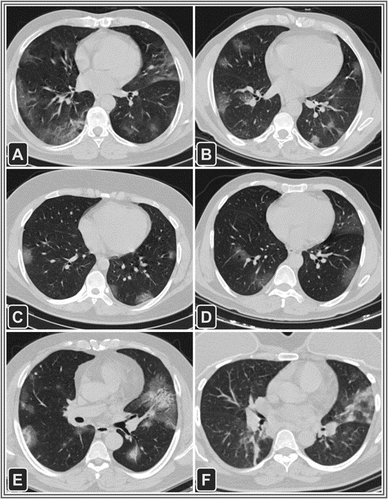Radiomics Gathered from CT Scans Predict Outcomes from COVID-19 Pneumonia
Features can be used to pinpoint which patients will most likely be admitted to the ICU, as well as patient outcomes.
Focusing on radiomics characteristics on non-contrast chest CT scans can help radiologists pinpoint which patients who have COVID-19-associated pneumonia are most likely to be admitted to the intensive care unit (ICU), a new study has revealed.
In an article published recently in Radiology: Cardiothoracic Imaging, investigators from Iran University of Medical Sciences and Harvard Medical School outlined how the features can help providers identify the patients who will need the most resource-heavy care, as well as predict patient outcomes.
“Along with the clinical variables, whole-lung radiomics can be a powerful tool for assessing diffuse pulmonary parenchymal diseases, such as viral pneumonia assessed in our study,” wrote the team led by Fatemah Homayounieh, M.D., radiology research fellow from Harvard. “Such prediction can help in allocation and planning of resources in high-prevalence diseases, such as the current COVID-19 pandemic.”
Transverse CT images of six patients with different outcomes (A, B) and management (C-F) for COVID-19 pneumonia. A: A 52-year-old man with diabetes mellitus, hypertension, and ischemic heart disease in his medical history, had a complete recovery and was discharged (CT severity score =13); B: A 55-year-old man with diabetes mellitus died from complications related to COVID-19 infection (CT severity score=12); C: A 25-year-old man who managed in outpatient setting (CT severity score=11); D: A 63-year-old man with diabetes mellitus was admitted into ICU for 9 days and then spent 5 days in non-ICU medical unit (CT severity score=14); E: A 49-year-old male with diabetes mellitus and hypertension was admitted to medical floor (CT severity score=17); F: A 54-year-old woman admitted to the ICU (CT severity score=12). (ICU: intensive care unit) Courtesy: Radiology: Cardiothoracic Imaging

Testing the predictive power of radiomics with CT is particularly important during the pandemic, the team said, because chest CT is a more readily-available method for diagnosing and assessing COVID-19-pneumonia in geographic locations that have limited access to RT-PCR tests, as well as with high-risk patients who initially test negative with the assay. Based on their evaluations of the scans, the team determined radiomics is more effective than radiologist analyses in predicting patient triage, disease severity, and outcomes.
To reach this conclusion, they evaluated 315 adult patients with COVID-19-associated pneumonia from a teaching hospital in Iran an compared how well radiologist interpretations, whole-lung radiomics, and the clinical outcomes that point to disease outcomes, severity, and patient triage performed. Each patient – 240 inpatients and 120 outpatients – underwent two CT scans that were examined by two radiologists. The providers graded the degree of pulmonary involvement, as well as the opacities identified in each lobe.
Using 2-mm images, both lungs were semi-automatically segmented, and a total of 1,690 radiomics features were pulled from the lung volumes, including both normal and abnormal lung parenchyma. Based on the analysis of these images, the team determined radiomics was more effective than radiologist interpretations in predicting patient outcomes and COVID-19 pneumonia severity. Incorporating clinical variables and lab data also augmented the identification of patients who needed ICU care and outcomes assessments.
Specifically, radiomics differentiated chest CT in outpatient versus inpatient with an area under the curve (AUC) of 0.84, and radiologist interpretations of disease extent and opacity had an AUC of 0.69. Whole-lung radiomics performed better than radiologists in predicting patient ICU admissions (AUC of 0.75 and 0.68, respectively) and death (AUC of 0.81 and 0.68, respectively). Implementing clinical variables with radiomics improved the AUC for predicting ICU admission to 0.84.
These results, the team said, support the use of whole-lung radiomics in radiology reports. Doing so can alleviate the workload for providers behind gathering radiomics data, but it will require the right datasets for a training model so meaningful inferences can be drawn.
GE HealthCare Debuts AI-Powered Cardiac CT Device at ACC Conference
April 1st 2025Featuring enhanced low-dose image quality with motion-free images, the Revolution Vibe CT system reportedly facilitates improved diagnostic clarity for patients with conditions ranging from in-stent restenosis to atrial fibrillation.
The Reading Room: Racial and Ethnic Minorities, Cancer Screenings, and COVID-19
November 3rd 2020In this podcast episode, Dr. Shalom Kalnicki, from Montefiore and Albert Einstein College of Medicine, discusses the disparities minority patients face with cancer screenings and what can be done to increase access during the pandemic.
Can Photon-Counting CT be an Alternative to MRI for Assessing Liver Fat Fraction?
March 21st 2025Photon-counting CT fat fraction evaluation offered a maximum sensitivity of 81 percent for detecting steatosis and had a 91 percent ICC agreement with MRI proton density fat fraction assessment, according to new prospective research.